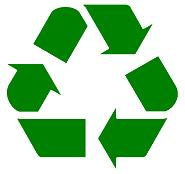 Recycling — the third ‘R’ — has become one of the most widely practised environmental activities in Canadian households. For good reason. It saves resources and helps keep waste out of the landfill. It is something anyone can do. Recycling is a multi-stage process that entails collecting, transporting, processing, marketing, remanufacturing, and ultimately using a material that would otherwise have been sent to landfill.
Recycling — the third ‘R’ — has become one of the most widely practised environmental activities in Canadian households. For good reason. It saves resources and helps keep waste out of the landfill. It is something anyone can do. Recycling is a multi-stage process that entails collecting, transporting, processing, marketing, remanufacturing, and ultimately using a material that would otherwise have been sent to landfill.
Of course, recycling is a cycle. So it is important not only to recycle everything we can, but also to purchase products with recycled content. This is what creates the market for recycled material and closes the recycling loop.
Recycling Q&A
- What can I put in my blue box or take to my local recycling depot? The answer to this varies from community to community across Manitoba. For Winnipeggers, the City has posted a Winnipeg recycling guide on its web site. The City of Brandon has a Brandon recycling guide. For other communities, check out information provided by Multi-Materials Stewardship Manitoba.
- What about items that are not standard blue box or depot materials? The City of Winnipeg offers advice about items like bulky waste, auto parts, and construction waste.
- What happens to the stuff I put into the blue box? Does it just get sent to landfill? No. Blue box materials do indeed actually get recycled. The City of Winnipeg posts information on current recycling destinations and uses on their web site. Also check out Multi-Material Stewardship Manitoba for lots more information on recycling of paper and packaging in Manitoba.
- What about old tires or used oil and filters? Manitoba has ‘stewardship’ programs for these two types of materials. For information on tire recycling, please check out Tire Stewardship Manitoba. For used oil and filters, the Manitoba Association for Resource Recovery Corporation has answers.
- See Green Action Centre’s other pages on electronics, cell phones and household hazardous waste for additional information on recycling.
Recycling Points to Ponder
 Aluminum is probably the most valuable blue box material. Producing a can from recycled aluminum takes only 5 per cent of the energy required to make a new can from bauxite ore.
Aluminum is probably the most valuable blue box material. Producing a can from recycled aluminum takes only 5 per cent of the energy required to make a new can from bauxite ore.- A stack of newspapers about one metre high equals one tree.
- The triangular symbol for recycling is called a Mobius loop. It was developed by a German mathematician, August Ferdinand Mobius in 1858. To make one, take a strip of paper, give it a half twist and join the ends together. If you take a pencil and make a line along the whole length of the loop without lifting the pencil, the mark will appear on both sides even though you did not turn the paper over. Go figure!
Recycling bags
Remember that in Winnipeg, the city recycling program does not take plastic bags. So please be sure not to leave your recyclables in a plastic bag. Use your blue box. A variety of re-usable bags are now available – we recommend ones that are washable and compact so you always have one with you.



Recent Comments